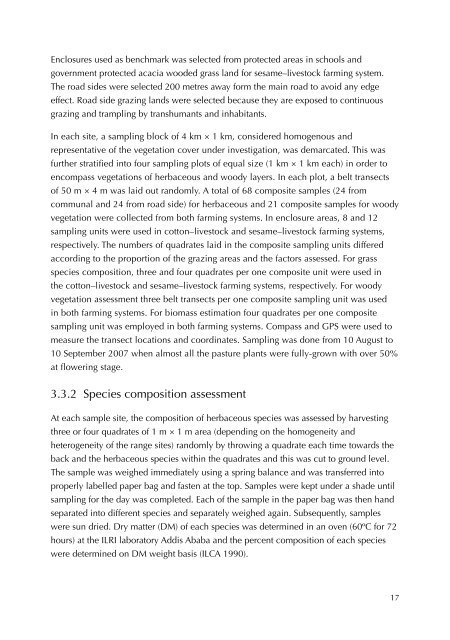Rangeland condition and feed resources in Metema District, North ...
Rangeland condition and feed resources in Metema District, North ...
Rangeland condition and feed resources in Metema District, North ...
You also want an ePaper? Increase the reach of your titles
YUMPU automatically turns print PDFs into web optimized ePapers that Google loves.
Enclosures used as benchmark was selected from protected areas <strong>in</strong> schools <strong>and</strong><br />
government protected acacia wooded grass l<strong>and</strong> for sesame–livestock farm<strong>in</strong>g system.<br />
The road sides were selected 200 metres away form the ma<strong>in</strong> road to avoid any edge<br />
effect. Road side graz<strong>in</strong>g l<strong>and</strong>s were selected because they are exposed to cont<strong>in</strong>uous<br />
graz<strong>in</strong>g <strong>and</strong> trampl<strong>in</strong>g by transhumants <strong>and</strong> <strong>in</strong>habitants.<br />
In each site, a sampl<strong>in</strong>g block of 4 km × 1 km, considered homogenous <strong>and</strong><br />
representative of the vegetation cover under <strong>in</strong>vestigation, was demarcated. This was<br />
further stratified <strong>in</strong>to four sampl<strong>in</strong>g plots of equal size (1 km × 1 km each) <strong>in</strong> order to<br />
encompass vegetations of herbaceous <strong>and</strong> woody layers. In each plot, a belt transects<br />
of 50 m × 4 m was laid out r<strong>and</strong>omly. A total of 68 composite samples (24 from<br />
communal <strong>and</strong> 24 from road side) for herbaceous <strong>and</strong> 21 composite samples for woody<br />
vegetation were collected from both farm<strong>in</strong>g systems. In enclosure areas, 8 <strong>and</strong> 12<br />
sampl<strong>in</strong>g units were used <strong>in</strong> cotton–livestock <strong>and</strong> sesame–livestock farm<strong>in</strong>g systems,<br />
respectively. The numbers of quadrates laid <strong>in</strong> the composite sampl<strong>in</strong>g units differed<br />
accord<strong>in</strong>g to the proportion of the graz<strong>in</strong>g areas <strong>and</strong> the factors assessed. For grass<br />
species composition, three <strong>and</strong> four quadrates per one composite unit were used <strong>in</strong><br />
the cotton–livestock <strong>and</strong> sesame–livestock farm<strong>in</strong>g systems, respectively. For woody<br />
vegetation assessment three belt transects per one composite sampl<strong>in</strong>g unit was used<br />
<strong>in</strong> both farm<strong>in</strong>g systems. For biomass estimation four quadrates per one composite<br />
sampl<strong>in</strong>g unit was employed <strong>in</strong> both farm<strong>in</strong>g systems. Compass <strong>and</strong> GPS were used to<br />
measure the transect locations <strong>and</strong> coord<strong>in</strong>ates. Sampl<strong>in</strong>g was done from 10 August to<br />
10 September 2007 when almost all the pasture plants were fully-grown with over 50%<br />
at flower<strong>in</strong>g stage.<br />
3.3.2 Species composition assessment<br />
At each sample site, the composition of herbaceous species was assessed by harvest<strong>in</strong>g<br />
three or four quadrates of 1 m × 1 m area (depend<strong>in</strong>g on the homogeneity <strong>and</strong><br />
heterogeneity of the range sites) r<strong>and</strong>omly by throw<strong>in</strong>g a quadrate each time towards the<br />
back <strong>and</strong> the herbaceous species with<strong>in</strong> the quadrates <strong>and</strong> this was cut to ground level.<br />
The sample was weighed immediately us<strong>in</strong>g a spr<strong>in</strong>g balance <strong>and</strong> was transferred <strong>in</strong>to<br />
properly labelled paper bag <strong>and</strong> fasten at the top. Samples were kept under a shade until<br />
sampl<strong>in</strong>g for the day was completed. Each of the sample <strong>in</strong> the paper bag was then h<strong>and</strong><br />
separated <strong>in</strong>to different species <strong>and</strong> separately weighed aga<strong>in</strong>. Subsequently, samples<br />
were sun dried. Dry matter (DM) of each species was determ<strong>in</strong>ed <strong>in</strong> an oven (60ºC for 72<br />
hours) at the ILRI laboratory Addis Ababa <strong>and</strong> the percent composition of each species<br />
were determ<strong>in</strong>ed on DM weight basis (ILCA 1990).<br />
17

















